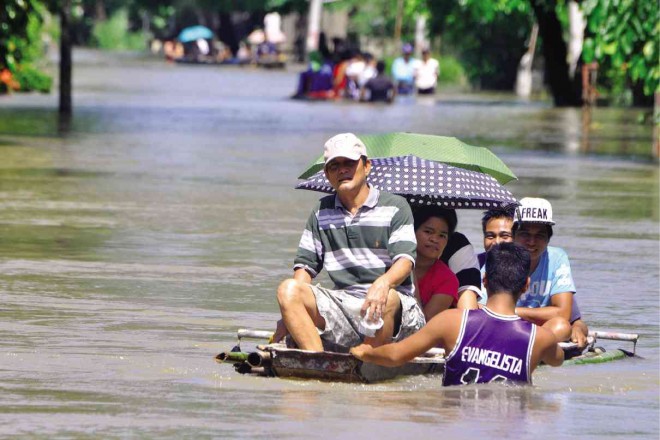Villages still flooded in Pangasinan

RESIDENTS of Barangay Lasip in Calasiao, Pangasinan province, take a boat ride from their houses to the town center as flood waters from the swollen Marusay River continue to submerge their village. WILLIE LOMIBAO / INQUIRER NORTHERN LUZON
CALASIAO, Pangasinan—The municipal council on Monday declared a state of calamity as more villages continued to be flooded despite sunny weather in the province since Sunday after weeklong monsoon rains.
Vice Mayor Roy Macanlalay said water from the swollen Marusay River led to heavy flooding in 17 of 24 villages. The river cuts through this town and passes through Dagupan City before draining into the Lingayen Gulf.
“We are the province’s catch basin here. With the water level rising, we continue to be alert,” Macanlalay said.
On Friday, local officials of Bani placed the municipality in the western part of the province under a calamity state.
Flooding has affected 10,699 families in Calasiao, with 54 families seeking refuge in the evacuation center. At 9 a.m. on Monday, water at the Marusay River was about 3 meters above the normal level, or 26 centimeters higher than Sunday’s reading.
Article continues after this advertisementA report on damage to roads, bridges, public buildings and agriculture was not yet available, Macanlalay said, but added that the floods had affected the livelihood of “puto” (rice cake) makers and vendors, “tinapa” (smoked fish) makers and tinsmiths.
Article continues after this advertisementThe villages of Lumbang and Dinalaoan, where the popular Calasiao puto is made, are heavily inundated.
On Monday, the Provincial Disaster Risk Reduction and Management Office (PDRRMO) said villages in the towns of Bayambang, Aguilar and Mabini were still flooded.
Two persons died in Bolinao, while two others were still missing in the towns of Sual and Manaoag. One of the fatalities was a 6-month-old baby, who was buried in a landslide.
In other areas, flood waters have receded, allowing families to return to their homes.
In Dagupan City, Mayor Belen Fernandez suspended classes in all levels in anticipation of continuous flooding caused by the overflowing Pantal River, which is connected to the Marusay River.
Supt. Christopher Abrahano, city police chief, said several streets in the interior villages had remained flooded, preventing vehicles from passing through. Flooded main streets in the city had slowed down traffic flow.
At least 51 families have been evacuated to the city’s astrodome.
In Baguio City, work crews opened a section of Marcos Highway, a major artery to the lowlands, in Tuba, Benguet province, which was blocked by a landslide on Sunday, said Edilberto Carabbacan, Cordillera director of the Department of Public Works and Highways.
Paving of stretches of city roads has resumed.
In Zambales province, the body of Arnel Encarnacion was found by his neighbors along the Buen River in Barangay Mambog in Botolan town, at 9 a.m. on Monday. Encarnacion, 57, was crossing the river at 3 p.m. on July 17 when a strong current swept him, his sister told authorities.
On Friday, Romeo Sunung, 13, drowned in the Salaza River in Palauig town, also in Zambales.
In Central Luzon, flood waters have receded fast after two days of cloudy to sunny weather, the Regional Disaster Risk Reduction and Management Council reported.
As of Monday, only eight villages in Pampanga province and three in Tarlac province remained flooded.
Strong rains whipped by the southwest monsoon flooded 90 villages in Pampanga, Nueva Ecija, Bataan, Tarlac and Bulacan last week. A total of 464 families (2,039 people) who sought refuge in 16 evacuation centers in the region began returning home.
Dry in Isabela
The monsoon spared farms in Isabela province, where rain was most needed.
Danilo Tumamao, provincial agriculturist, said damage to 28 hectares of corn farms due to a sustained dry spell cost farmers up to P98 million.
Farmer Expedito Bayucan of Lullutan said his corn plants had wilted due to lack of heavy rain in the past six weeks.
Tumamao said farm yield was expected to drop by only 10 percent, pointing out that the drought affected only more than 24,000 hectares of the 235,774 ha of land planted with corn.
No rainfall was recorded even in watershed areas such as in Magat and Dumayup, said Wilfredo Gloria, operations manager of the National Irrigation Administration-Magat River Integrated Irrigation System.
In Bulacan, more than two weeks of rain led to a substantial rise in the water level of Angat Dam, the major source of potable water for Metro Manila.
On Monday, the dam’s reservoir posted 179.80 meters above sea level (masl), according to a report to the PDRRMO. It will take only more than 0.20 masl to breach the the facility’s critical level of 180 masl. Gabriel Cardinoza and Villamor Visaya Jr., Inquirer Northern Luzon; and Tonette Orejas and Carmela Reyes-Estrope, Inquirer Central Luzon